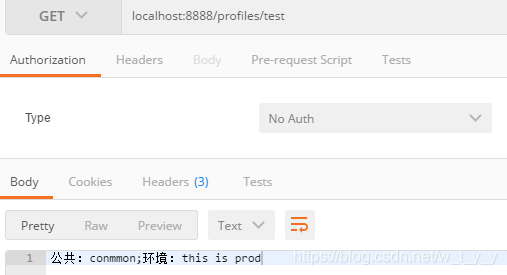
springboot实现多环境配置spring.profiles.active
spring.profiles.active=@spring.profiles.active@
一、spring.profiles.active介绍:
springboot项目中,我们经常把一些变量参数写在application.properties文件中,但是不同的环境参数可能不一样,spring.profiles.active可以区分环境。多环境配置的文件名需要满足application-{profile}.properties的格式,其中{profile}对应环境标志,如
application-dev.properties开发环境配置文件
application-test.properties测试环境配置文件
application-prod.properties生产环境配置文件然后在默认配置文件中通过spring.profiles.active来指定,指定也有两种方式:
1、手动指定:这种方法切换环境需要修改配置文件,不够方便
spring.profiles.active = {profile}
#如spring.profiles.active = prod2、打包自动指定:
二、demo:
1、启动类:
package com;
import org.springframework.boot.SpringApplication;
import org.springframework.boot.autoconfigure.SpringBootApplication;
@SpringBootApplication
public class ProfilesApplication {
public static void main(String args[]){
SpringApplication.run(ProfilesApplication.class,args);
}
}
2、多环境配置文件:
开发环境application-dev.properties:
zt.profiles = this is dev测试环境application-test.properties
zt.profiles = this is test生产环境application-prod.properties
zt.profiles = this is prod3、接口:
package com.controller;
import org.springframework.beans.factory.annotation.Value;
import org.springframework.web.bind.annotation.RequestMapping;
import org.springframework.web.bind.annotation.RestController;
@RestController
public class TestController {
@Value("${zt.common}")
private String common;
@Value("${zt.profiles}")
private String profilesStr;
@RequestMapping("/test")
public String getStr(){
return "公共:"+common+";环境:"+profilesStr;
}
}
4、下面分别列下手动、自动方法的区别写法:
(1) 手动方法:
pom:
<?xml version="1.0" encoding="UTF-8"?>
<project xmlns="http://maven.apache.org/POM/4.0.0"
xmlns:xsi="http://www.w3.org/2001/XMLSchema-instance"
xsi:schemaLocation="http://maven.apache.org/POM/4.0.0 http://maven.apache.org/xsd/maven-4.0.0.xsd">
<modelVersion>4.0.0</modelVersion>
<groupId>com.profiles</groupId>
<artifactId>profiles-demo</artifactId>
<version>1.0-SNAPSHOT</version>
<parent>
<groupId>org.springframework.boot</groupId>
<artifactId>spring-boot-starter-parent</artifactId>
<version>1.4.1.RELEASE</version>
</parent>
<dependencies>
<dependency>
<groupId>org.springframework.boot</groupId>
<artifactId>spring-boot-starter-web</artifactId>
</dependency>
</dependencies>
</project>默认配置文件:
server.port= 8888
server.context-path=/profiles
spring.profiles.active=prod
zt.common = conmmonmvn clean package打包测试一下:


这时候我们打包带参数,如mvn clean package -Ptest、mvn clean package -Pdev、mvn clean package -Pprod,打包后的仍然是prod,就是说必须手动修改application.properties中的环境。
(2)自动方法:
在pom中添加以下配置:
<profiles>
<!-- 测试环境 -->
<profile>
<id>test</id>
<activation>
<activeByDefault>true</activeByDefault>
</activation>
<properties>
<spring.profiles.active>test</spring.profiles.active>
</properties>
</profile>
<!-- 开发环境 -->
<profile>
<id>dev</id>
<activation>
<activeByDefault>false</activeByDefault>
</activation>
<properties>
<spring.profiles.active>dev</spring.profiles.active>
</properties>
</profile>
<!-- 生产环境 -->
<profile>
<id>prod</id>
<activation>
<activeByDefault>false</activeByDefault>
</activation>
<properties>
<spring.profiles.active>prod</spring.profiles.active>
</properties>
</profile>
</profiles>并把application.properties中的profiles指定改为
spring.profiles.active=@spring.profiles.active@这时候打包使用mvn clean package -Ptest、mvn clean package -Pdev、mvn clean package -Pprod,打出来的就是指定环境的包了。pom文件中test一项默认是true,所以如果不指定环境直接使用mvn clean package打包就是test环境。
idea启动则可以点击右侧的maven,选择环境勾上,再启动服务即可:

如我勾上prod:

启动服务访问的为prod环境:

再去掉prod,勾上test:

重启服务访问的为test:

更多推荐
 已为社区贡献9条内容
已为社区贡献9条内容










所有评论(0)